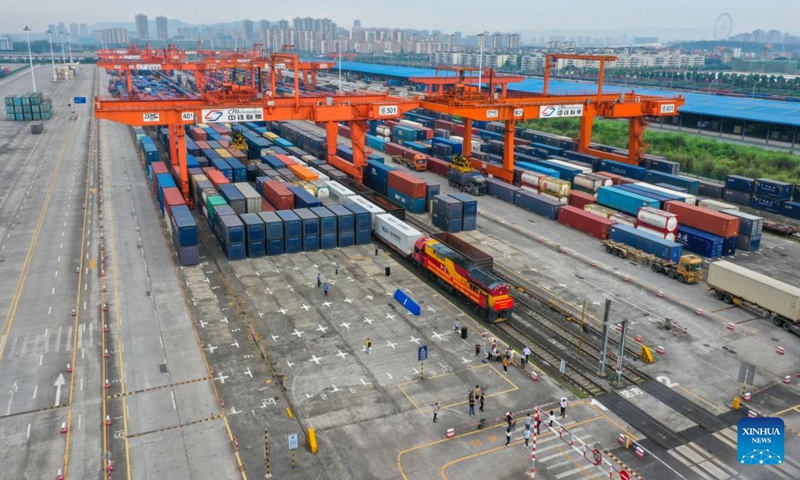
In this aerial photo, an outbound international freight train is about to depart from a station in southwest China's Chongqing, June 16, 2022. The first outbound international freight train for test from China's Chongqing to South Asia pulled out of a station in southwest China's Chongqing Municipality on Thursday. The new route from Chongqing to Nepal's capital Kathmandu can save about 20 days on the way compared with traditional logistics routes.(Photo: Xinhua)
China's Foreign Ministry on Thursday reiterated a plan to use China's aid funds for Nepal to support the feasibility study for a cross-border railway linking China and the South Asian nation, injecting optimism into enhanced connectivity that'll give a big economic boost to the landlocked Himalayan country.
The link would enable Nepal-origin products to readily access China's huge market and facilitate bilateral investment and trade flows, a veteran regional affairs observer said, envisioning the cross-border railway to be a significant part of a rail network spanning China, Nepal and India if regional integration makes good progress.
Asked about the plan for the cross-border railway at a regular press briefing on Thursday, Chinese Foreign Ministry spokesperson Wang Wenbin referred to a meeting between the Chinese and Nepali foreign ministers on Wednesday and reiterated an announcement made by State Councilor and Foreign Minister Wang Yi regarding the railway.
During the meeting with Nepali Foreign Minister Narayan Khadka in Qingdao, East China's Shandong Province, Wang Yi announced that China will use aid funds for Nepal to support the feasibility study of the China-Nepal cross-border railway, and will send experts to Nepal to conduct the survey work within this year.
The two sides also agreed to build the Trans-Himalayan Multi-Dimensional Connectivity Network, according to a statement.
The cross-border railway project, if eventually built, would surely augur well for Nepal's economy, as the landlocked country's transport connectivity with China currently relies on a few land ports that can't operate amid heavy snow or geologic disasters, Long Xingchun, president of the Chengdu Institute of World Affairs, told the Global Times on Thursday.
Long said that the rail link will allow Nepal to tap into China's huge market and facilitate bilateral trade and investment flows.
The construction of the China-Nepal cross-border railway is an important consensus reached by the leaders of the two countries in the field of connectivity, and it is also the earnest expectation of the two peoples, Chinese Ambassador to Nepal Hou Yanqi told the Global Times in an exclusive interview earlier this year.
"The railway departments of the two countries have coordinated and communicated with each other many times, completed the pre-feasibility study and other preparations, and made important progress," Hou said.
The ambassador cited technical problems, among other challenges confronting the rail link that needs to cross the Himalayas.
There would be a section of less than 200 kilometers with a drop height of over 1,000 meters. That means that it needs to solve many technical difficulties such as complex geological conditions and frequent natural disasters along the way.
According to preliminary calculations, the bridge-to-tunnel ratio of the entire railway exceeds 90 percent, and the construction cost per kilometer is about 200 million yuan ($29.68 million).
It's hoped that the "Nepali side will further improve the business environment, strengthen policy stability and support, and promote the practical implementation of large-scale infrastructure projects such as cross-border railways, so as to realize the common dream of the two peoples at an early date," Hou remarked.
In the words of Long, "China's engineering prowess would suffice to fix the technical woes and the rail project's implications for Nepal's economy go beyond working out the formula for returns on the rail investment over the short term."
Furthermore, as Long pointed out, if regional integration could press ahead, the China-Nepal cross-border railway could be part of a broader rail network linking the two countries and India that would smooth out trade and investment flows among Southwest China, Nepal and northern India.




